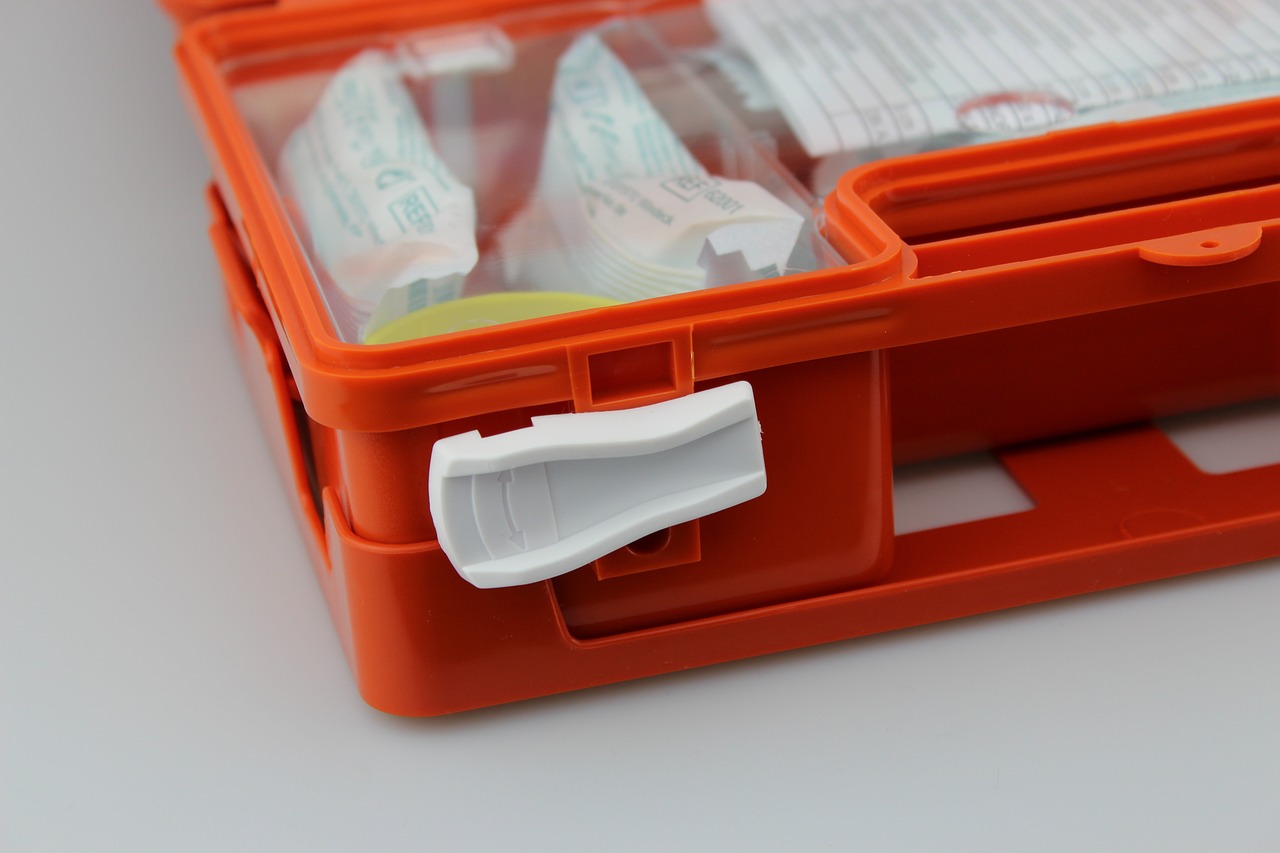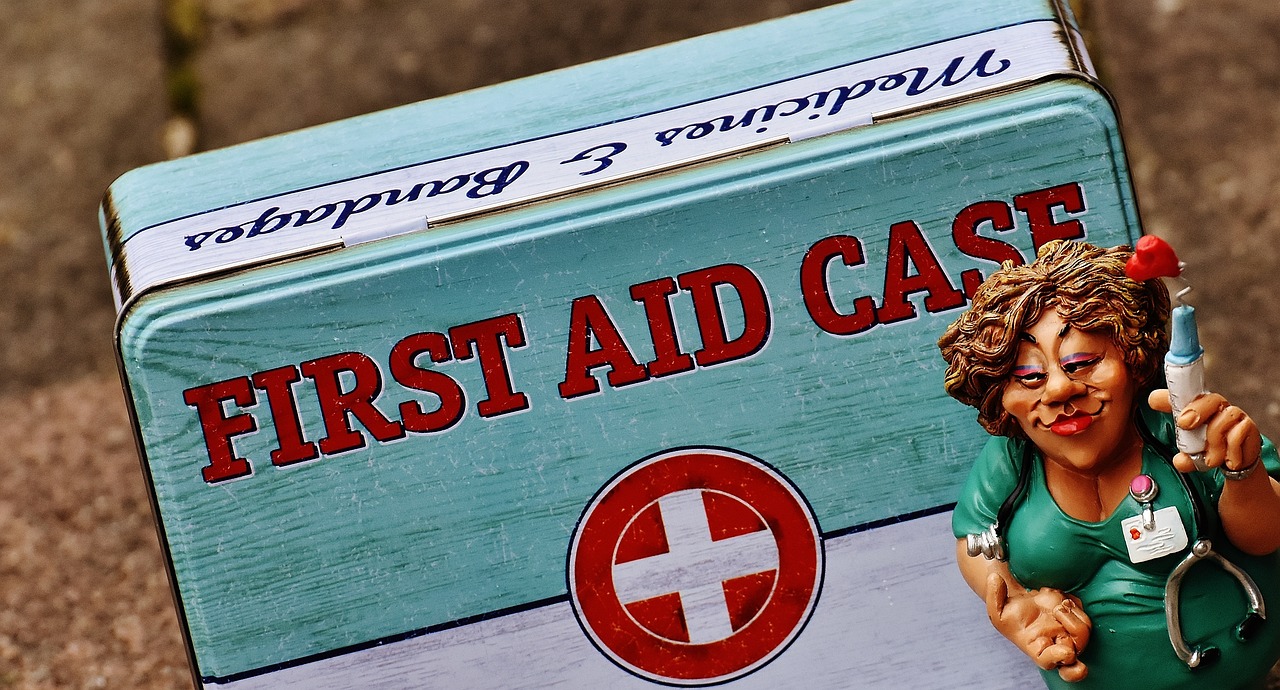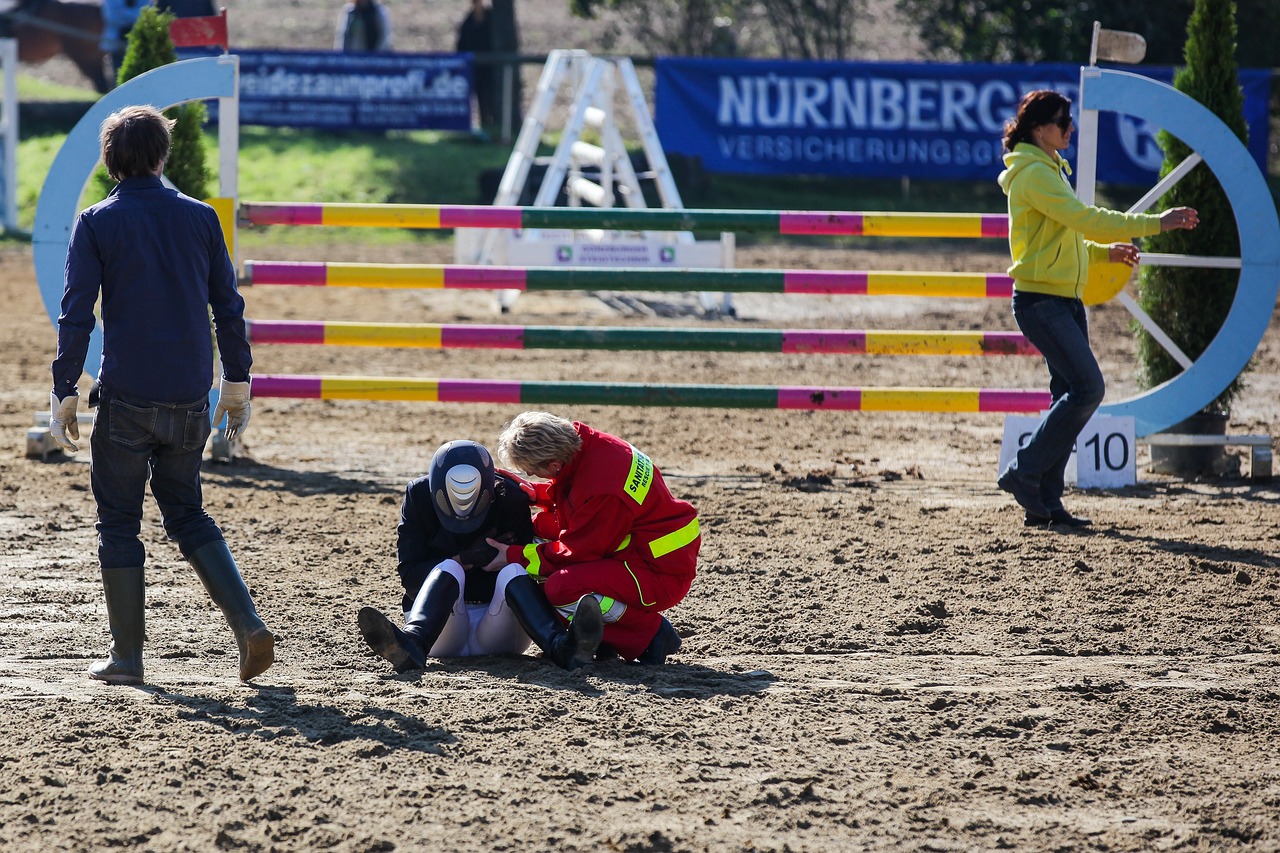The Importance of Basic First Aid Training in Schools
In today's fast-paced world, where emergencies can arise unexpectedly, the significance of basic first aid training in schools cannot be overstated. Imagine a scenario where a student collapses during gym class or suffers a serious injury during recess. In such moments, having individuals who can act swiftly and effectively can mean the difference between life and death. First aid training equips students and staff with essential skills that not only foster a sense of confidence but also cultivate a culture of safety within educational institutions. By integrating first aid training into the school curriculum, we are not just teaching students how to respond to emergencies; we are empowering them to take charge of their own safety and the safety of those around them.
The benefits of first aid training extend far beyond just learning how to bandage a wound or perform CPR. It instills a sense of responsibility and preparedness that can last a lifetime. When students know how to handle emergencies, they are more likely to remain calm and collected in stressful situations. This training also promotes teamwork and communication skills, as students often work together in simulations and practice scenarios. Furthermore, a school that prioritizes safety through first aid training sends a strong message to students and parents alike: that the well-being of everyone in the school community is a top priority.
Moreover, the long-term impact of first aid training on student safety and well-being is profound. Students who receive this training are not only prepared for emergencies within the school environment but also carry these skills into their homes and communities. This ripple effect can lead to a more informed and safety-conscious society. Therefore, implementing first aid training in schools is not just an educational enhancement; it is a vital investment in the future of our children and communities.
First aid training is a powerful tool that equips students with essential life-saving skills, fostering both confidence and preparedness in emergency situations. It promotes a culture of safety within schools, enhancing overall well-being. The immediate benefits include:
- Life-Saving Skills: Students learn how to respond to various emergencies, potentially saving lives.
- Increased Confidence: Knowing how to act in emergencies boosts students' self-esteem and readiness.
- Community Awareness: Trained students contribute to a safer school environment and community.
By integrating first aid training into the school curriculum, we ensure that every student has access to this vital education, preparing them for the unexpected challenges life may throw their way.
Integrating first aid training into the school curriculum is key to ensuring that all students receive this essential education. There are effective methods for incorporating first aid lessons into existing subjects, such as health education or physical education classes. For instance, teachers can include practical first aid exercises within their lessons, allowing students to practice skills in a controlled environment. This hands-on approach not only makes learning engaging but also reinforces the importance of being prepared for emergencies.
To maximize understanding and retention, first aid training must be tailored to different age groups. Younger students benefit from simple concepts and hands-on activities, while older students can tackle more complex scenarios. This approach ensures that the training is relevant and effective, keeping students engaged and interested in learning these crucial skills.
At the elementary level, training focuses on basic concepts and simple techniques. Engaging methods, such as role-playing and interactive games, can help teach young children about first aid. For example, using stuffed animals to demonstrate bandaging techniques can make the learning process fun and memorable. By fostering a positive learning environment, we can help children develop a foundational understanding of first aid that they can build upon as they grow.
High school students are capable of handling more complex scenarios, and this training should reflect that. Advanced topics such as cardiopulmonary resuscitation (CPR), the use of an Automated External Defibrillator (AED), and managing severe injuries can be introduced. By preparing them for real-life emergencies, we are not only enhancing their skill set but also instilling a sense of responsibility and readiness that can last a lifetime.
Offering certification programs in schools can enhance the credibility of first aid training. Certification not only validates the skills learned but also provides students with a tangible accomplishment that they can include in their resumes. Various certification options, such as those provided by the American Red Cross or the National Safety Council, can be explored to ensure that students receive high-quality training.
In addition to students, training teachers and staff is crucial. Educators are often the first responders in emergencies, and equipping them with first aid skills ensures immediate response when it matters most. Workshops and seminars can provide comprehensive training, enhancing their knowledge and confidence in handling emergencies.
Organizing workshops and seminars for staff can be an effective way to enhance first aid knowledge. These events can be tailored to address specific needs within the school, ensuring that educators are well-prepared for various scenarios. Engaging expert trainers can further enrich these sessions, providing staff with valuable insights and hands-on experience.
Regular refresher courses are essential to ensure that staff remain updated on first aid practices. Continuous education helps maintain skills and keeps educators informed about the latest techniques and guidelines. This commitment to ongoing training reflects a school’s dedication to safety and preparedness.
Engaging the community in first aid training initiatives can significantly strengthen school safety. Partnerships with local organizations can enhance training opportunities and provide additional resources. Collaboration with local health services can lead to expert-led training sessions, ensuring that students and staff receive the best instruction possible.
Partnering with local health services offers numerous benefits, including access to expert knowledge and resources. By working together, schools can organize training sessions that are informative and engaging, ensuring that participants feel confident in their abilities to respond to emergencies.
Involving parents and guardians in first aid training fosters a supportive environment. Strategies for encouraging family participation in school training programs can include informational meetings, family workshops, or community events. By creating a culture of safety that extends beyond school walls, we can ensure that everyone is prepared to act in emergencies.
1. Why is first aid training important for students?
First aid training is crucial for students as it equips them with life-saving skills, boosts their confidence, and promotes a culture of safety within the school environment.
2. How can first aid training be integrated into the school curriculum?
First aid training can be integrated into existing subjects, such as health or physical education, through practical exercises and hands-on activities that engage students.
3. What age-appropriate training methods can be used for young children?
Engaging methods like role-playing, interactive games, and demonstrations with stuffed animals can make learning about first aid fun and memorable for young children.
4. How can schools ensure that staff are adequately trained in first aid?
Schools can organize workshops and seminars, provide ongoing training, and offer refresher courses to ensure that staff remain knowledgeable about first aid practices.
5. What role do parents play in first aid training initiatives?
Parents can participate in training sessions, support school initiatives, and help create a culture of safety at home and in the community.

Benefits of First Aid Training
First aid training is not just a set of skills; it's a lifeline in emergencies. Imagine a situation where a friend collapses during a sports game or a classmate has a severe allergic reaction. In these critical moments, having the knowledge and skills to act can mean the difference between life and death. First aid training equips students with essential life-saving skills, fostering confidence and preparedness in emergency situations. This training goes beyond just knowing what to do; it instills a sense of responsibility and awareness in students, making them more vigilant and proactive in their environments.
Moreover, first aid training promotes a culture of safety within schools. When students are educated about how to handle emergencies, they contribute to a safer school environment. This not only enhances the overall well-being of students but also creates a supportive community where everyone looks out for one another. Schools that prioritize first aid training tend to have a lower incidence of accidents and injuries, as students are more likely to intervene appropriately when they see someone in distress.
Furthermore, the benefits of first aid training extend beyond the classroom. The skills learned can be applied in various aspects of life, whether at home, during extracurricular activities, or even in future workplaces. This training helps students develop critical thinking and problem-solving skills, as they learn to assess situations quickly and determine the best course of action. In essence, first aid training is an investment in the students' future, equipping them with tools that will serve them for a lifetime.
To illustrate the impact of first aid training, consider the following table that summarizes key benefits:
| Benefit | Description |
|---|---|
| Life-Saving Skills | Equips students with the knowledge to act in emergencies effectively. |
| Increased Confidence | Empowers students to take control in crisis situations. |
| Cultural Shift | Fosters a community that prioritizes safety and well-being. |
| Critical Thinking | Enhances decision-making skills under pressure. |
In conclusion, the benefits of first aid training are profound and far-reaching. It not only prepares students for emergencies but also cultivates a culture of safety and responsibility within schools. As we consider the importance of equipping our youth with essential life skills, it becomes clear that first aid training is a critical component of a well-rounded education.
- What is first aid training? First aid training teaches individuals how to provide immediate care in emergencies, including basic life support and injury management.
- Who can benefit from first aid training? Everyone, including students, teachers, and parents, can benefit from first aid training, as it equips them with essential skills for emergencies.
- How often should first aid training be updated? It is recommended to refresh first aid training every two years to stay updated on best practices and techniques.
- Are there any age restrictions for first aid training? No, first aid training can be adapted for all age groups, from young children to adults, ensuring that everyone can learn these vital skills.

Curriculum Integration
Integrating first aid training into the school curriculum is not just a good idea; it's a necessity that can save lives. By embedding these vital lessons into existing subjects, schools can ensure that every student, regardless of their background, receives this essential education. Imagine a classroom where students are not only learning about science or history but also about how to handle emergencies. This holistic approach not only makes learning more engaging but also equips students with skills that can be crucial in real-life situations.
One effective method to integrate first aid training is through thematic units. For instance, during a health education module, teachers can introduce basic first aid concepts alongside discussions about personal health and safety. This allows students to see the direct application of their learning and understand why these skills are important. Additionally, teachers can collaborate with local health professionals to provide guest lectures or hands-on workshops, making the learning experience more dynamic and interactive.
Moreover, incorporating first aid training into physical education classes can enhance students' understanding of teamwork and leadership. When students learn to perform CPR or bandage a wound, they are not only gaining practical skills but also learning to work together in high-pressure situations. This can foster a sense of community and responsibility among students, making them more aware of their surroundings and the importance of helping others.
To further enhance the integration of first aid training, schools can consider establishing a first aid club or a student-led initiative. This can serve as a platform for students to take ownership of their learning and encourage their peers to participate in training sessions. By promoting a culture of safety and preparedness, schools can create an environment where students feel empowered to act in emergencies. The key is to make first aid training a part of the school culture, rather than a one-off lesson.
In conclusion, integrating first aid training into the school curriculum is a multifaceted approach that not only benefits students academically but also prepares them for life outside the classroom. It's about creating a generation that is not only knowledgeable but also capable of responding effectively in emergencies. With the right strategies in place, schools can make first aid training an essential part of the educational experience.

Age-Appropriate Training
When it comes to teaching first aid skills to students, age-appropriate training is not just a nice-to-have; it’s a must. Think of it like learning to ride a bike—what works for a five-year-old is vastly different from what a teenager needs to know. By tailoring first aid training to various age groups, we can maximize understanding and retention, ensuring that the lessons stick with them for life.
For younger children, the focus should be on basic concepts and simple techniques. At this stage, the goal isn't to turn them into mini paramedics but to instill a sense of confidence and awareness in emergency situations. We can use engaging methods like storytelling, role-playing, and interactive games to make learning both fun and effective. For instance, a simple game where children practice calling for help or bandaging a toy can make a lasting impression. This hands-on approach keeps them engaged and helps them remember what they’ve learned.
As students progress to middle school, their cognitive abilities expand, allowing for more complex scenarios. Here, we can introduce topics such as CPR, the use of an Automated External Defibrillator (AED), and how to recognize the signs of a heart attack or stroke. The training can also include discussions about emotional responses during emergencies, teaching them not only the physical skills but also how to stay calm under pressure. This age group can benefit from group activities where they can practice these skills together, fostering teamwork and communication.
High school students are ready for more advanced training. At this level, the curriculum can cover a broader spectrum of emergency situations, including trauma care and the management of severe injuries. This is where we can incorporate real-life scenarios through simulations, allowing students to apply their knowledge in a controlled environment. For instance, setting up a mock accident scene can help them practice their response skills in a realistic setting, preparing them for actual emergencies. Additionally, high school students can even take on leadership roles in teaching younger students, reinforcing their own learning while spreading awareness.
In summary, providing age-appropriate first aid training is crucial for developing a generation of confident, capable individuals who are prepared to respond in emergencies. By adapting our teaching methods and materials to suit different developmental stages, we can ensure that every student, regardless of age, is equipped with the essential skills they need to make a difference when it matters most.

Elementary Level Training
When it comes to teaching first aid at the elementary level, the focus should be on making the learning process engaging and accessible. Young children are naturally curious, and this curiosity can be harnessed to instill essential life-saving skills. The key is to simplify complex concepts into fun and relatable lessons that resonate with their everyday experiences. For instance, using storytelling can be an effective way to introduce basic first aid scenarios. Imagine a story where a character encounters a minor injury while playing; this not only captures their attention but also provides a practical context for what they are learning.
To facilitate this learning, educators can incorporate hands-on activities that allow students to practice basic techniques. Simple exercises such as bandaging a stuffed animal or learning how to call for help can make all the difference. By using props and interactive methods, students are more likely to remember what they’ve learned. In fact, studies have shown that interactive learning significantly enhances retention rates among young learners.
Moreover, it is essential to address the emotional aspect of first aid training. Teaching children how to stay calm in emergencies can be just as important as teaching them the technical skills. Role-playing scenarios where they must react to a friend who has fallen or is hurt can help them practice emotional resilience in a safe environment. This not only empowers them but also builds a culture of care and responsibility among peers.
In terms of curriculum integration, schools can dedicate specific time slots for first aid training, perhaps even as part of health education classes. To ensure that the training is age-appropriate, educators can break down the lessons into manageable segments. Here’s a brief overview of what can be covered:
| Age Group | Topics Covered |
|---|---|
| 5-7 years | Basic hygiene, calling for help, simple bandaging |
| 8-10 years | Recognizing emergencies, basic first aid techniques, simple CPR |
By tailoring the content to their developmental stage, children can grasp the importance of first aid without feeling overwhelmed. This approach not only makes learning enjoyable but also instills a sense of responsibility towards their own safety and the safety of others. Ultimately, the goal is to cultivate a generation that is not only aware of first aid but also prepared to act in times of need.

High School Level Training
When it comes to first aid training for high school students, the focus shifts to more complex scenarios that require critical thinking and quick decision-making skills. At this stage, students are not just learning to bandage a cut or perform CPR; they are diving deep into the intricacies of emergency response. This training is crucial as it prepares them for real-life situations where every second counts. Imagine a scenario where a fellow student collapses during a game or a friend suffers a severe allergic reaction. The knowledge gained from first aid training can be the difference between life and death.
High school students are capable of understanding advanced topics such as cardiopulmonary resuscitation (CPR), choking relief techniques, and the use of an automated external defibrillator (AED). These skills not only empower them to take action during emergencies but also instill a sense of responsibility and confidence. To make the training engaging and effective, schools can incorporate various teaching methods, such as:
- Hands-on practice: Allowing students to practice techniques on mannequins or through role-playing scenarios enhances their learning experience.
- Interactive workshops: Bringing in professionals from local health services to conduct workshops can provide real-world insights and expertise.
- Simulation drills: Conducting mock emergencies can help students apply their skills in a controlled environment, preparing them for actual situations.
Moreover, it’s essential to integrate discussions about mental health and emotional support into the training. Understanding how to assist someone who is not only physically injured but also emotionally distressed can create a more comprehensive first aid responder. High school students should be taught how to recognize signs of shock, anxiety, or panic in others and how to provide reassurance while waiting for professional help.
Another important aspect of high school level training is the opportunity for students to earn certifications. Programs such as American Red Cross First Aid/CPR/AED certification not only enhance their resumes but also provide them with a sense of accomplishment. Schools can facilitate this by organizing certification courses that fit into the school schedule, making it easier for students to participate.
In conclusion, high school first aid training is not just about learning to treat injuries; it’s about fostering a generation that is prepared to respond to emergencies with knowledge, confidence, and compassion. The skills gained during this training can have a lasting impact, not only on the students themselves but also on their peers and the broader community. By equipping students with these essential skills, schools are not only promoting safety but also encouraging a culture of care and responsibility.
Q: Why is first aid training important for high school students?
A: First aid training equips students with essential skills to respond effectively in emergencies, potentially saving lives and promoting a culture of safety.
Q: What specific skills do high school students learn in first aid training?
A: They learn advanced skills such as CPR, AED usage, choking relief techniques, and how to provide emotional support in emergencies.
Q: Can first aid training be incorporated into existing subjects?
A: Yes, first aid training can be integrated into health education, physical education, or even science classes to enhance learning and engagement.
Q: Are there certification programs available for high school students?
A: Yes, many organizations offer certification programs that can be conducted in schools, enhancing students' credentials and confidence.
Q: How can parents get involved in first aid training?
A: Schools can encourage parents to participate in training sessions or workshops, fostering a supportive community focused on safety.

Certification Programs
Implementing in schools is a game-changer when it comes to first aid training. Not only do these programs provide students with a sense of accomplishment, but they also enhance the credibility of the training they receive. Imagine a school where every student walks out with a certificate in first aid; it’s like giving them a superpower that they can carry with them for life. With a certification, students are not just learning about first aid; they are becoming qualified responders who can take action in emergencies.
There are various certification options available, tailored to different age groups and skill levels. For instance, organizations like the American Red Cross and the National Safety Council offer comprehensive courses that can be adapted for school settings. These programs often cover essential topics such as CPR, wound care, and how to respond to common emergencies, ensuring that students are well-equipped to handle real-life situations.
Furthermore, certification programs can also foster a sense of community and responsibility among students. When they achieve certification, they not only gain personal confidence but also contribute to a culture of safety within their school. This ripple effect can lead to a more prepared and vigilant student body. Schools can even organize special events to celebrate students who complete their training, creating a buzz around the importance of first aid.
To give you a clearer picture, here’s a brief overview of some popular certification programs:
| Certification Program | Target Age Group | Key Features |
|---|---|---|
| American Red Cross | Elementary to High School | CPR, First Aid, and AED training |
| National Safety Council | Middle to High School | Comprehensive emergency response training |
| St. John Ambulance | All ages | Hands-on practice and real-life scenarios |
Incorporating these programs into the school curriculum not only enriches the educational experience but also empowers students to act decisively in emergencies. With the right training and certification, they can become the heroes of their own stories, ready to leap into action when it matters most. So, why not take that first step and advocate for first aid certification in your school? It’s an investment in our children’s future and safety that pays off in countless ways.
1. Why is first aid certification important for students?
First aid certification is crucial because it equips students with the skills and knowledge to respond effectively in emergencies, potentially saving lives.
2. At what age can students start receiving first aid training?
Students can begin receiving basic first aid training as early as elementary school, with age-appropriate content tailored to their understanding.
3. How often should first aid training be refreshed?
It's recommended that first aid training be refreshed every two years to ensure that skills and knowledge remain current.
4. Can parents participate in first aid training programs?
Absolutely! Involving parents in training programs can enhance community support and foster a culture of safety at home and in schools.

Training for Staff and Teachers
When it comes to ensuring a safe environment in schools, is absolutely vital. Think about it: teachers are often the first responders in any emergency situation within the school premises. They are the ones who interact with students daily, and their ability to act quickly and effectively can make a huge difference in the outcome of an emergency. By equipping educators with essential first aid skills, we are not just preparing them for emergencies; we are instilling a culture of safety that resonates throughout the entire school community.
Moreover, having trained staff can significantly reduce the panic that often accompanies emergencies. Imagine a scenario where a student has a medical crisis. If teachers are well-trained, they can administer immediate care, which can stabilize the situation until professional help arrives. This immediate response not only saves lives but also reassures students and parents that the school prioritizes their safety.
To implement effective training, schools can organize workshops and seminars specifically designed for educators. These sessions can cover a range of topics, including CPR, wound care, and the management of common injuries like sprains or fractures. The beauty of these workshops is that they can be tailored to meet the specific needs of the school, considering factors such as the age of students and the types of activities that occur on campus. For instance, a school with a robust sports program may focus more on sports-related injuries.
Additionally, schools should consider offering ongoing training and refreshers to ensure that staff members remain up-to-date with the latest first aid techniques and protocols. Just like any other skill, first aid knowledge can become rusty over time. Regular refreshers can help maintain confidence and competence among staff, ensuring they are always prepared to act in emergencies. This ongoing education can take various forms, such as online courses, in-person workshops, or even brief training sessions during staff meetings.
To facilitate this process, schools can create a training schedule that outlines when and how often these sessions will occur. This schedule can be shared with all staff members to encourage participation and ensure that everyone is on the same page regarding first aid preparedness. Here’s a simple example of what that training schedule might look like:
| Month | Training Topic | Duration | Instructor |
|---|---|---|---|
| January | Basic First Aid | 2 hours | Local Health Expert |
| March | CPR and AED Training | 3 hours | Certified Trainer |
| May | Emergency Response Plan Review | 1 hour | School Nurse |
In conclusion, investing in first aid training for staff and teachers is not just a good idea; it is a necessary step in creating a safe and supportive learning environment. By prioritizing this training, schools can ensure that their educators are well-prepared to handle emergencies, thereby enhancing the overall safety and well-being of students. Remember, a well-trained staff is a confident staff, and confidence can be the difference between chaos and calm in a crisis.
Q1: Why is first aid training important for teachers?
A1: First aid training equips teachers with essential skills to respond effectively in emergencies, ensuring the safety and well-being of students.
Q2: How often should staff receive first aid training?
A2: It's recommended that staff participate in refresher courses at least once a year to stay updated on first aid practices.
Q3: What topics are typically covered in first aid training for educators?
A3: Common topics include CPR, wound care, choking relief, and management of common injuries.
Q4: Can first aid training be integrated into professional development days?
A4: Absolutely! Many schools incorporate first aid training into their professional development schedules to ensure all staff members are trained.

Workshops and Seminars
Organizing workshops and seminars for teachers and staff is a fantastic way to enhance first aid knowledge within schools. These events serve not only as a platform for learning but also as a community-building exercise, fostering collaboration among educators. Imagine a room filled with enthusiastic teachers, all eager to learn how to save a life; it’s an inspiring sight! Workshops can be tailored to meet the specific needs of the school, ensuring that the content is relevant and engaging.
During these workshops, participants can engage in hands-on activities that simulate real-life scenarios. For instance, conducting mock drills where teachers practice CPR or learn how to handle choking incidents can be incredibly beneficial. This practical approach helps to reinforce the knowledge gained and builds confidence in their ability to respond effectively during emergencies. Additionally, inviting local health professionals to lead these sessions not only enriches the training but also provides credibility. These experts can share insights and experiences that deepen the understanding of first aid practices.
Moreover, seminars can focus on broader topics such as mental health first aid or emergency preparedness in schools, addressing the comprehensive needs of students and staff alike. The interactive nature of these events encourages questions and discussions, allowing educators to voice their concerns and share experiences. By creating a supportive atmosphere, schools can cultivate a culture of safety that extends beyond just basic first aid skills.
To maximize the effectiveness of these workshops and seminars, schools can consider the following strategies:
- Scheduling Regular Sessions: Offering these training sessions on a regular basis ensures that the knowledge remains fresh and relevant.
- Incorporating Feedback: Gathering feedback from participants can help improve future workshops, making them more tailored to the needs of the staff.
- Creating a Resource Library: Providing access to first aid manuals, videos, and other materials can serve as ongoing resources for staff.
In conclusion, workshops and seminars are essential components in equipping school staff with the necessary first aid skills. By investing time and resources into these training events, schools not only enhance the safety of their environment but also empower educators to act decisively in emergencies, ultimately ensuring the well-being of their students.
Q1: How often should first aid workshops be held in schools?
A1: It’s recommended to hold first aid workshops at least once a year, with refresher courses every six months to keep skills updated.
Q2: Can parents participate in these workshops?
A2: Absolutely! Involving parents not only strengthens the community but also ensures that families are prepared to handle emergencies.
Q3: What topics should be covered in first aid training?
A3: Essential topics include CPR, choking response, wound care, and recognizing signs of serious medical conditions. Mental health first aid is also becoming increasingly important.

Ongoing Training and Refreshers
In the realm of first aid, knowledge is only as good as its application. This is why ongoing training and refresher courses are essential for maintaining the skills and confidence of both staff and students. Just like a car needs regular maintenance to run smoothly, our first aid skills require periodic check-ups to ensure they are up to date and effective. Imagine being in a critical situation where every second counts; wouldn't you want to be absolutely sure that you can perform the necessary actions without hesitation?
Regular refresher courses not only help in retaining important information but also introduce new techniques and updates in first aid practices. The medical field is constantly evolving, and so are the guidelines for first aid. By participating in these refresher courses, staff and students can stay informed about the latest protocols and innovations. For instance, the introduction of new CPR techniques or changes in the use of automated external defibrillators (AEDs) can be critical knowledge that saves lives.
Moreover, these training sessions can serve as a platform for team-building. When staff members engage in training together, they foster a sense of camaraderie and trust, which is essential during actual emergencies. To make the most of these sessions, schools can adopt a few strategies:
- Schedule Regular Sessions: Set aside specific times throughout the school year for these training sessions. Consistency is key!
- Incorporate Scenario-Based Training: Use real-life scenarios to make the training more engaging and relatable. This method enhances retention and prepares participants for actual emergencies.
- Feedback and Evaluation: After each training, gather feedback to evaluate the effectiveness of the session. This will help in improving future training programs.
In addition to scheduled refresher courses, schools can also encourage staff to pursue online training modules that can be completed at their convenience. This flexibility allows educators to learn at their own pace, ensuring that they can fit this important training into their busy schedules. Online platforms often provide interactive content, quizzes, and even certification upon completion, which can further motivate staff to engage in ongoing education.
Ultimately, the goal of these ongoing training and refresher courses is to create a culture of safety and preparedness within the school environment. By ensuring that everyone is equipped with the latest knowledge and skills, schools not only enhance their immediate response capabilities but also instill a sense of confidence among staff and students alike. So, let's not wait for an emergency to remind us of the importance of being prepared; let's make ongoing training a priority!
Q: How often should refresher courses be conducted?
A: It is recommended to conduct refresher courses at least once a year to ensure that skills and knowledge remain current.
Q: Can online training be as effective as in-person training?
A: Yes, online training can be very effective, especially when it includes interactive elements and assessments. However, in-person training often provides hands-on experience that is invaluable.
Q: What topics should be covered in refresher courses?
A: Refresher courses should cover basic first aid skills, CPR, the use of AEDs, and any new guidelines or techniques that have emerged since the last training session.
Q: Is there a cost associated with ongoing training?
A: Costs can vary depending on the provider and the format of the training. Many schools partner with local health organizations to offer free or low-cost training sessions.

Community Involvement
Engaging the community in first aid training initiatives is not just beneficial; it’s essential for creating a safe and supportive environment in schools. When schools partner with local organizations, they not only enhance the training opportunities available but also foster a sense of community responsibility. Imagine a school where students, parents, and local health professionals collaborate to ensure that everyone is equipped with essential life-saving skills. This collective effort can dramatically improve the overall safety and well-being of students.
One effective way to promote community involvement is by organizing first aid training sessions that are open to both students and their families. These sessions can be designed to accommodate various age groups and skill levels, ensuring that everyone, from young children to adults, can participate and learn. By inviting local health services to lead these workshops, schools can provide expert instruction that is both credible and relevant. This not only enhances the quality of the training but also builds trust within the community.
Furthermore, fostering collaboration with local health services can lead to a variety of benefits:
- Expert-Led Training: Professionals can share their real-world experiences, making the training more engaging and practical.
- Resource Accessibility: Local health organizations may provide materials and resources that schools might not have access to otherwise.
- Ongoing Support: These partnerships can offer continuous support and updates on best practices in first aid.
Involving parents and guardians in first aid training is another key aspect of community involvement. When families participate, they not only learn valuable skills but also create a supportive environment for their children. Schools can encourage this participation by hosting family-oriented events, such as “First Aid Nights,” where parents and children can learn together. This approach not only reinforces the importance of first aid training but also strengthens family bonds as they work together to acquire new skills.
Moreover, schools can utilize social media and community boards to spread awareness about upcoming training sessions and the importance of first aid knowledge. By actively promoting these initiatives, schools can reach a broader audience and encourage more community members to get involved. The more people who are trained in first aid, the safer the community becomes. Together, we can create a culture of preparedness that extends beyond the school walls.
In conclusion, community involvement in first aid training not only enhances the safety of students but also builds a stronger, more connected community. By collaborating with local health services and actively engaging parents, schools can ensure that first aid training is a shared responsibility. This collective approach not only empowers students with essential skills but also promotes a culture of safety that benefits everyone.
Q: Why is community involvement important in first aid training?
A: Community involvement ensures that first aid training is accessible to everyone, fostering a culture of safety and preparedness that extends beyond the school environment.
Q: How can parents participate in first aid training?
A: Parents can participate by attending workshops, family-oriented training events, and volunteering to help organize these initiatives in collaboration with schools.
Q: What are the benefits of partnering with local health services?
A: Partnering with local health services provides expert-led training, access to resources, and ongoing support, enhancing the overall quality and effectiveness of first aid education.
Q: Are there age-specific first aid training programs?
A: Yes, training programs can be tailored to different age groups to ensure that the content is appropriate and engaging for all participants.

Collaboration with Local Health Services
When it comes to enhancing first aid training in schools, is an invaluable strategy. Imagine a scenario where students not only learn theoretical aspects of first aid but also get to practice under the guidance of seasoned professionals. This partnership can transform the training experience from a simple classroom lecture into a dynamic, hands-on learning environment that truly prepares students for emergencies.
Local health services, including hospitals, clinics, and community health organizations, often have access to resources and expertise that can significantly enrich a school's first aid program. These organizations can provide trained medical personnel to conduct workshops, offer real-life insights, and even share the latest updates on health and safety protocols. For instance, a local paramedic might demonstrate how to perform CPR or how to handle choking incidents, bringing a level of realism that textbooks simply cannot provide.
Furthermore, these collaborations can lead to the development of specialized training sessions tailored to the needs of the school community. Schools can work with health professionals to identify common health issues in their area, such as allergies or asthma, and offer targeted training that prepares students and staff to respond effectively. This proactive approach not only equips everyone with essential skills but also fosters a culture of safety and awareness.
To illustrate the potential benefits of such collaborations, consider the following table that outlines key advantages:
| Advantage | Description |
|---|---|
| Expert Guidance | Access to trained professionals who can provide accurate information and practical demonstrations. |
| Resource Availability | Utilization of local health services' resources, such as training materials and equipment. |
| Community Engagement | Strengthening ties between schools and the community, fostering a supportive environment for health education. |
| Customized Training | Ability to tailor training programs to address specific health concerns prevalent in the school population. |
Moreover, engaging local health services can also open doors to ongoing training opportunities. Many health organizations are eager to establish long-term partnerships with schools, which means that first aid training can become a regular feature of the curriculum rather than a one-off event. This continuity not only reinforces the skills learned but also keeps the school community updated on the latest first aid practices.
Involving local health services in first aid training is not just about skills acquisition; it’s about building a comprehensive support network that prioritizes the health and safety of students. When schools and health services come together, they create a powerful alliance that enhances the educational experience and prepares students to respond effectively in emergencies.
- Why is collaboration with local health services important for first aid training? Collaboration provides access to expertise, resources, and customized training that enhances the overall effectiveness of first aid education.
- How can schools initiate partnerships with local health services? Schools can reach out to local hospitals or health organizations, propose training sessions, and discuss mutual benefits to establish a partnership.
- What types of training can local health services provide? Local health services can provide CPR training, emergency response drills, and information on handling specific health issues like allergies or asthma.

Parent and Guardian Participation
When it comes to first aid training in schools, the involvement of parents and guardians is not just beneficial; it's essential. Imagine a scenario where a child suffers a minor injury during recess. If their peers are trained in first aid but the adults around them are not, the situation could escalate unnecessarily. By actively participating in first aid training, parents and guardians can help create a safer environment for their children. This partnership fosters a community where everyone feels empowered to respond effectively in emergencies.
One effective strategy to encourage parent and guardian participation is to organize interactive workshops. These workshops can be designed to be engaging and informative, allowing parents to learn alongside their children. This not only strengthens their first aid skills but also enhances family bonds through shared experiences. Moreover, when parents see the value of first aid training, they are more likely to support its implementation in schools. They can advocate for the program, helping to secure necessary resources and funding.
Additionally, schools can utilize various communication channels to reach out to parents. Sending newsletters, creating social media posts, or hosting informational sessions can raise awareness about the importance of first aid training. Schools might also consider offering incentives for participation, such as certificates of completion or recognition in school events. This acknowledgment can motivate parents to engage actively in the training process.
Furthermore, collaboration with local health organizations can enhance these training initiatives. By inviting healthcare professionals to lead sessions, parents can gain insights from experts, making the training more credible and impactful. This collaboration not only enriches the training experience but also builds a network of support within the community. When parents and guardians are involved, they can help reinforce the lessons learned in school, ensuring that first aid knowledge is consistently applied at home as well.
In conclusion, the participation of parents and guardians in first aid training is vital for cultivating a culture of safety within schools. By actively engaging in the training process, they not only improve their own skills but also contribute to a supportive environment that prioritizes the well-being of all students. This collaborative effort can make a significant difference in how emergencies are handled, ultimately leading to a safer and more prepared school community.
- Why is parent participation in first aid training important?
Parent participation ensures that there is a consistent approach to first aid both at school and at home, creating a safer environment for children. - How can parents get involved in first aid training?
Parents can participate by attending workshops, advocating for training programs, and collaborating with schools to enhance training opportunities. - What are the benefits of involving local health services?
Involving local health services provides expert-led training, ensuring that the information shared is accurate and up-to-date. - Are there any incentives for parents to participate?
Schools may offer certificates or recognition during events to encourage parent involvement in first aid training.
Frequently Asked Questions
- Why is first aid training important for students?
First aid training is crucial for students as it equips them with essential life-saving skills. Imagine being in a situation where someone is injured, and you’re the only one who can help. Knowing how to respond can make a significant difference, not just in the outcome but also in boosting the confidence of the student. It promotes a culture of safety in schools, enhancing overall well-being for everyone.
- How can first aid training be integrated into the school curriculum?
Integrating first aid training into the school curriculum can be achieved through various methods, such as incorporating lessons into health education or physical education classes. By weaving first aid concepts into existing subjects, schools can ensure that all students receive this vital education without overwhelming their schedules. It’s like adding a new flavor to a dish; it enhances the overall experience!
- What age-appropriate training methods are effective for different grade levels?
Age-appropriate training methods vary significantly between elementary and high school students. For younger children, using engaging and simple techniques, like role-playing or interactive games, can make learning fun and memorable. In contrast, high school students can handle more complex scenarios, such as CPR and advanced first aid techniques. Tailoring the training to their developmental stage ensures that they grasp the concepts effectively.
- Are there certification programs available for first aid training in schools?
Yes, many schools offer certification programs that enhance the credibility of their first aid training. These programs provide students with recognized certifications, which can be beneficial for their future, whether in college applications or job opportunities. It’s like earning a badge of honor that showcases their commitment to safety and preparedness.
- Why is it important for teachers and staff to receive first aid training?
Teachers and staff play a critical role in ensuring student safety. By equipping them with first aid skills, they can respond immediately in emergencies, providing essential care before professional help arrives. Imagine a scenario where a student gets hurt; having trained staff can be the difference between a minor issue and a major crisis.
- How can schools involve the community in first aid training initiatives?
Engaging the community in first aid training initiatives can significantly strengthen school safety. Schools can partner with local health services to provide expert-led training sessions, making the learning experience richer and more informative. Additionally, involving parents and guardians fosters a supportive environment that extends beyond the school walls.
- What are the benefits of organizing workshops and seminars for staff?
Workshops and seminars provide comprehensive training for staff, ensuring they are well-prepared to handle emergencies. These events can be interactive and informative, allowing staff to practice skills in a supportive setting. Regular training helps maintain a high level of readiness, just like a sports team practicing together to stay sharp for the big game!
- How often should refresher courses be conducted for staff?
Regular refresher courses are essential to keep staff updated on the latest first aid practices. Ideally, these should be conducted at least once a year, but more frequent sessions can be beneficial, especially after significant updates in first aid protocols. Just like keeping your car in top shape with regular maintenance, ongoing training ensures that staff are always ready to respond effectively.



















